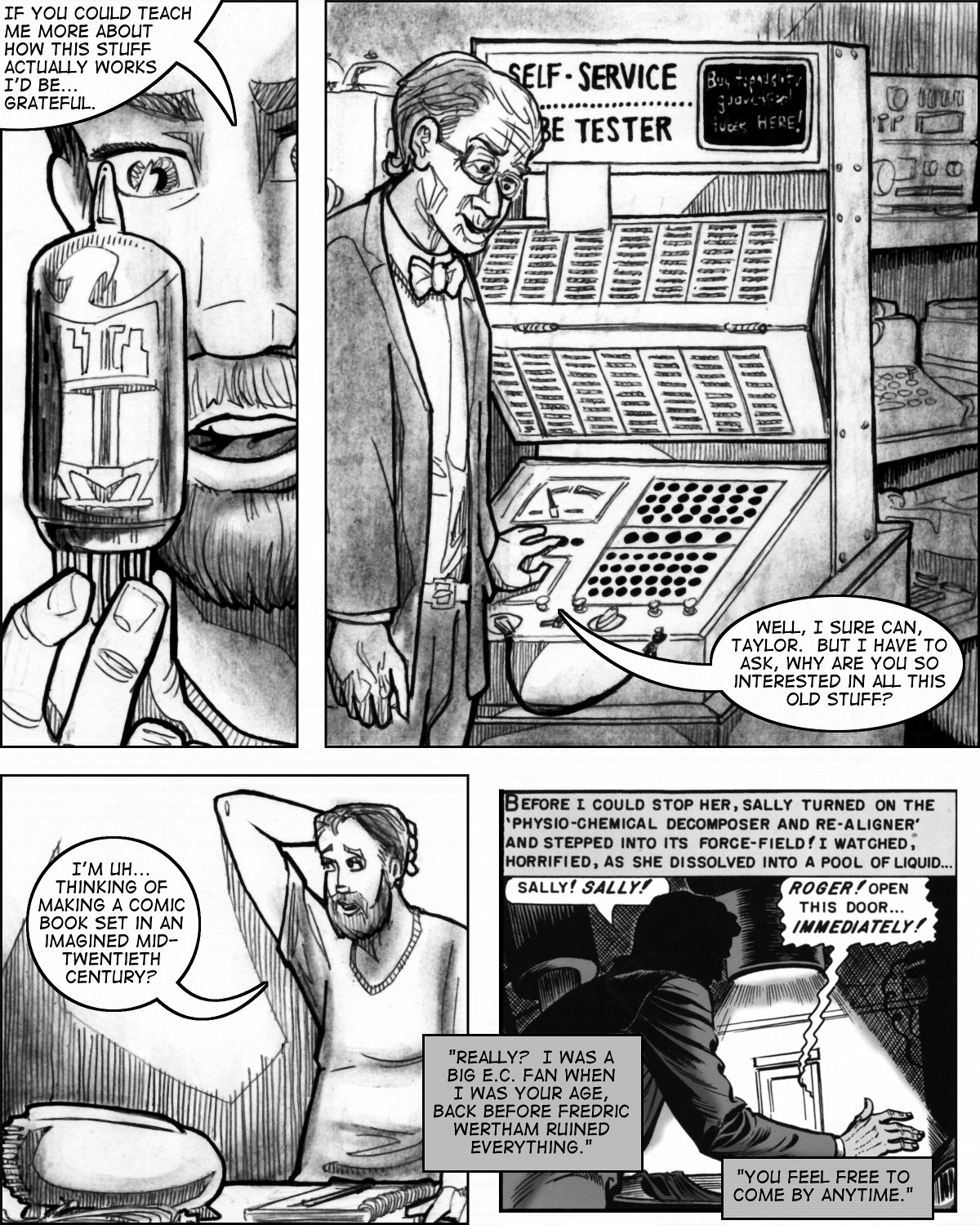Page


This work is licensed under a Creative Commons Attribution-NonCommercial-ShareAlike 4.0 International License.



This work is licensed under a Creative Commons Attribution-NonCommercial-ShareAlike 4.0 International License.
I’m sure Bill Gaines would have approved. Original post here.
Original text:
What was it over at Weird Science? Did the spirit move Bill Gaines about once a year to shout across the office to Al Feldstein, “Al, we really need another story about a melting woman. Write one up and get Jack Kamen to draw it, stat!”
Well, maybe so. From Weird Science #6 (March/April 1951):
Similar conceit to that of “Something Missing,” down to the agreeable fetishist’s detail of her melting out of her clothes.
Here’s the context, taken from the story “Divide and Conquer.” A middle-aged scientist is working on a technology — in this case, some sort of drug — that causes living organisms to dissolve, divide, and re-form. Consistent with the principle of conservation of mass (Science!) the re-formed organisms will be copies of the original, but half-sized unless they do so in the presence of an appropriate nutritive medium.
Our scientist is married to a beautiful woman and, because he lives in the EC fictional universe, it’s a horrid marriage. She’s cheating on him and plotting murder. She discovers to her considerable sorrow that it’s pretty tough to murder someone who can copy himself, and it’s even tougher when the surviving copy returns to exact retribution with his copying formula.
(Ah, suggestions of comic book nudity. And created by science! And of course entirely-necessary-as-part-of the-plot-nothing-exploitative-here-please-move-along.)
Of course, since there are now two Glorias, this isn’t just the liquid girl fetish in action, but an early example also of personal identity porn. The question of which is the “real” Gloria is just as salient here as the questions of which is the “real” Iris or the “real” Jill in the Gnosis College scripts.
Sometimes, I’m almost afraid that someday I’ll be perusing Weird Science and come across the trope of a whole college full of reckless, oversexed students and a faculty which regards them as experiment fodder…
Al Feldstein and Jack Kamen back at Weird Science sure seemed to like the liquid girl trope. I’ve found another example, this one from Weird Science #15 (September/October 1952).
What on earth is going on here? Well, it’s yet another story of loneliness and sexual failure. Melvin Sputterly is a bachelor who lives alone in rented rooms. One day he receives a mysterious package bearing a postmark from the year 2952 and, internally, a label reading “De Luxe Personal Harem Kit: Not for sale to minors or married men!” A package from the far future! And it contains — dehydrated harem girls. Just follow the directions that involve adding certain quantities of water and table salt.
How interesting that there’s still a Post Office that uses physical postmarks in 2952, also that at least some norms of sexual propriety from 1952 continue to flourish almost a thousand years into the future. (Focus on the Family must be so pleased.) But one thing that hasn’t endured that long are units of measure familiar to Melvin, or us. So he has to experiment. The first experiment produces a girl rather to plump for Melvin’s tastes, so he administers a solvent (included in the package) that causes her to dissolve away, thus the panel above.
Melvin tries the other girls, but manages to mess up their rehydrations as well, making girls to skinny, small, large, etc. He rejects them all, dissolving them as he did the first.
Perhaps Melvin Sputterly deserves to be a lonely bachelor living in rented rooms.
…in the matter of the whole Apsinthion Protocol/liquid girl thing.
Time I guess for another one of my melancholy Dr.-Fausuts-has-no-original-ideas posts.
 A word first on how we might have gotten to the strange situation depicted in the panel above, and the provenance of the art. It’s a panel from Weird Science #7, not a comix-format of the 1985 John Hughes movie, but an actual series put out in by famous EC Comics. EC’s publisher William Gaines is an underacknowledged hero of American culture. His comics lines broke new ground in many areas including horror and science fiction. He acted defiant in front of a persecuting congressional committee. He put an African-American character in a position of high competence and responsibility at a time when they were largely confined to menial or comic relief roles in mainstream fiction. And when it became impossible to sustain his comics-making enterprise in the face of cultural backlash, he founded Mad magazine, which I’ll bet did more to train the satirical intelligence of generations of young Americans than any other publication — a latter-day American Mercury for the adolescent set. A great story, which you can find entertainingly told in David Hajdu‘s The Ten-Cent Plague: The Great Comic Book Scare and How it Changed America (click on image to the left).
A word first on how we might have gotten to the strange situation depicted in the panel above, and the provenance of the art. It’s a panel from Weird Science #7, not a comix-format of the 1985 John Hughes movie, but an actual series put out in by famous EC Comics. EC’s publisher William Gaines is an underacknowledged hero of American culture. His comics lines broke new ground in many areas including horror and science fiction. He acted defiant in front of a persecuting congressional committee. He put an African-American character in a position of high competence and responsibility at a time when they were largely confined to menial or comic relief roles in mainstream fiction. And when it became impossible to sustain his comics-making enterprise in the face of cultural backlash, he founded Mad magazine, which I’ll bet did more to train the satirical intelligence of generations of young Americans than any other publication — a latter-day American Mercury for the adolescent set. A great story, which you can find entertainingly told in David Hajdu‘s The Ten-Cent Plague: The Great Comic Book Scare and How it Changed America (click on image to the left).
But before Mad and all that, EC had Weird Science, a pioneer of science-fiction comics. The stories were largely written by Gaines and Al Feldstein, and drawn by a remarkable set of comics artists the included Harvey Kurtzman, Joe Orlando, and the great Wally Wood. Though the story of this post, “Something Missing!” was written by Feldstein and drawn by Jack Kamen.
Submitted for your consideration: Professor Roger Lawrence is miserably married to Hannah, a shrewish middle-aged woman who rides him hard to give up his experiments and teach more classes so that they can have more money. It’s not his fault: Professor Lawrence’s life is the way it is because he lives in the EC Comics fictional universe, where bitterly unhappy marriages are the norm. They drive plots forward, you see. Lawrence finds comfort in two things: the laboratory in which he has just perfected an amazing machine he calls the “Physio-Chemical Decomposer and Re-aligner,” and his pretty blond undergraduate research assistant, Sally Chadwick.
Lawrence and Sally successfully test the machine on a mouse, which they decompose into slime, then recompose into — a piece of cheese. Sally’s explanation: “…that’s what it was thinking about when the machine dissolved it.” They reverse the process, restoring the mouse. Then, of course, they fall in love.
Well, Hannah is not pleased at all when she sniffs out this turn of events. She marches to the laboratory and demands admission. Sally is trapped: there will be scandal, ruin, unless she can improvise a method of escape. And, being a brilliant as well as a beautiful girl, she quickly improvises one — leaping into Lawrence’s amazing machine and melting herself into something else! (Thus the panel above. For the fetishist, the detail of Sally’s abandoned dress and shoes on the edge of the machine really makes the scene.)
However, this does not work out quite as well as one might have hoped once Hannah storms in.
Doubtless an “oh shit” moment for Professor Lawrence. For Dr. Faustus, though, it was a moment of marvel, because not only has Feldstein anticipated the whole “liquid girl” scenario, but in having Sally turn herself into a statue, he’s also anticipated the whole A.S.F.R. thing. I mean, damn! (And don’t get me started on the whole professor-scientist/student experimentee thing.) Probably the deepest thrill, though, comes from the willingness of the girl to jump into the machine.
All is not lost, though, because Lawrence still has his machine. Or…
I’ve omitted the last panel, because your imaginations may be better than fiction. But if you really must you can, with some effort, find a reprint of the story.